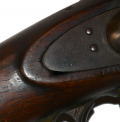site search
online catalog
SCARCE LEMAN MILITIA RIFLE

$3,295.00
Quantity Available: 1
Item Code: 490-6825
Shipping: Determined by Method & Location of buyer
To Order:
Call 717-334-0347,
Fax 717-334-5016, or E-mail
This is a very good example of a scarce rifle. Henry E. Leman made just 300 or so rifles of this pattern, including some variations. This is all original and complete with ramrod, sights, bands, springs, etc – everything but the sling swivels, and uses combination of brass mounts and iron barrel bands. These are rifles, rather than rifle muskets, and were sold privately to individuals, militia units, and other arms merchants: Moller thinks some of them may have made it into US contracts fulfilled by P.S. Justice, though Leman himself did not have any luck with the U.S. government. Best known for his plains and Indian trade rifles, he solicited a U.S. contract for rifles in October 1861, but was told sufficient contracts had already been let, though he was encouraged to contact the Ordnance Office when he had suitable military rifles for direct sale. A second attempt in August 1862, backed up by a sample rifle, was met with a similar response.
The rifle has a good fit of wood to metal, with the brass mounts showing a pleasing, mellow patina with some thin brown, age toning, the iron showing a deep, generally smooth, brown, and the wood a warm medium brown. The edges of the forestock are good, as are those of the ramrod channel with just a little wear forward of the lower band. There are some slight chips to the lockplate mortise at the rear of the plate, and some small handling marks on the counterpane, with one lengthwise shallow drag line. The butt shows some minor rubs on the flats near the buttplate. There is a tiny bit of chipping at rear of the breechplug tang from recoil and a slight gap on either side at the front.
The barrel is .58 caliber, 33-inches long, with front blade sight and rear, standing leaf, notched sight in place. The metal is brown in color, matching the two iron barrel bands, back to the breech, which shows as silver gray and brown with pitting from firing percussion caps, obscuring any markings, with the nipple showing some flattening and corrosion around its base. The bolster, with a raised shield at rear, shows shallow pitting at the top, and the screw slot shows turning. The hammer and lock plate are good- smooth metal with the hammer brown with some blue tones and the plate showing some caramel with faint blue mottling, and showing clear lockplate markings: “LEMAN / LANCTR.PA.” Bore is dark and dirty with some rifling visible. Mechanics function but very tight/stiff.
Given the variations in metal for the barrel bands, placement of springs, etc., even in the small number produced, Leman rifles qualify as a collecting category of their own, though they fit well also among arms made by other Pennsylvania makers who tried to enter the military market at the beginning of the war. This is a scarce military rifle. [sr][ph:L]
DISCLAIMER: All firearms are sold as collector's items only - we do not accept responsibility as to the shooting safety or reliability of any antique firearm. All firearms are described as accurately as possible, given the restraints of a catalog listing length. We want satisfied customers & often "under" describe the weapons. Any city or state regulations regarding owning antique firearms are the responsibility of the purchaser. All firearms are "mechanically perfect" unless noted, but again, are NOT warranted as safe to fire!
~~~~~~~~~~~~~~~~~~~~~~~~~~~~~~~~~~~
THIS ITEM, AS WITH ALL OTHER ITEMS AVAILABLE ON OUR WEB SITE,
MAY BE PURCHASED THROUGH OUR LAYAWAY PROGRAM.
CLICK HERE FOR OUR POLICIES AND TERMS.
THANK YOU!
Inquire About SCARCE LEMAN MILITIA RIFLE
For inquiries, please email us at [email protected]
Most Popular
Historical Firearms Stolen From The National Civil War Museum In Harrisburg, Pa »
Theft From Gravesite Of Gen. John Reynolds »
Selection Of Unframed Prints By Don Troiani »
Fine Condition Brass Infantry Bugle Insignia »
British Imported, Confederate Used Bayonet »
Scarce New Model 1865 Sharps Still In Percussion Near Factory New »
featured item
28th NEW JERSEY PAINTED REGIMENTAL EAGLE DRUM IDENTIFIED TO DRUMMER AARON BUZZEE, COMPANY K: FREDERICKSBURG AND CHANCELLORSVILLE!
This Civil War regimental eagle drum has a totally original painted designation to the 28th New Jersey and drummer Aaron Buzzee of Company K. The regiment enlisted for just nine months service in Fall 1862, but found itself in two momentous battles:… (766-1858). Learn More »
site search
Upcoming Events
May 16 - 18: N-SSA Spring Nationals, Fort Shenandoah, Winchester, VA Learn More »



















